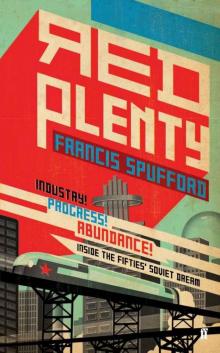- Home
- Francis Spufford
Backroom Boys Page 2
Backroom Boys Read online
Page 2
Rockets may eventually prove to have importance for other things than delivering megaton bombs. However, though it is risky to predict the future of a revolutionary new development, I am not aware of any possible non-military application of rocket development from which it would damage us as a nation to be excluded.
More pressing were the strategic problems that were becoming apparent with Blue Streak. When it was planned, liquid fuelling was the only option in rocket design. Since then, both the Americans and the Soviet Union had developed solid fuel for rockets, a mixture which set like toffee inside missile casings, allowing them to remain ready for quick launching month after month in their silos. Blue Streak had to be laboriously pumped up with kerosene and liquid oxygen refrigerated to –183°C. Desperate ideas were proposed to make Blue Streak ‘survivable’, to make it a credible threat even after a direct hit on its silo by one of Russia’s nippier nukes. The silos could have six-hundred-ton steel and concrete lids. Or there could be gigantic hoses to wash away the charred debris of Suffolk that would have fallen on top of them. The truth was that, in the new world of the four-minute warning, the seven-minute Blue Streak had become a weapon that could only be used for a first strike. It offered a terrible combination of vulnerability and destabilising menace.
In April 1960, to jeers from the Labour Party about wasted money, the Macmillan government cancelled it and bought Polaris from America instead. However, the effort to build Blue Streak had made Britain the European leader in rocket engineering, and policymakers were not yet ready to give that up. Now the civil exploitation of space got its chance. Despite an invitation by NASA to launch scientific payloads free, Britain persuaded France, Italy and West Germany to join it in the European Launcher Development Organisation, or ELDO, an attempt to build a European satellite launcher using Blue Streak as a first stage. ELDO was driven by Macmillan’s European policy, though, and British negotiators mistook De Gaulle’s enthusiasm about sharing military high technology for support for Britain’s application to join the Common Market. After his definitive non, ELDO was condemned to a slow death by waning British commitment and failure after failure on a technical level while the partner countries learned the technology. ‘Europa 1’ never flew, but its Blue Streak first stage never failed.
It was around this time that an encounter took place between two outlooks almost equally marginal to the spirit of the time in Britain. Arthur C. Clarke, by now a well-established science-fiction writer as well as author of the pioneering paper on satellite communications, had been growing increasingly irritated by the theological science fiction of C. S. Lewis, who saw space travel as a sinful attempt by fallen humanity to overstep its God-given place. In Reflections on the Psalms (1958), for example, Lewis had described it as learning ‘(which God forbid) to … distribute upon new worlds the vomit of our own corruption’. Clarke contacted Lewis and they arranged to meet in the Eastgate Tavern, Oxford. Clarke brought Val Cleaver as his second; Lewis brought along J. R. R. Tolkien. They saw the world so differently that even argument was scarcely possible. As Orwell said about something completely different, their beliefs were as impossible to compare as a sausage and a rose. Clarke and Cleaver could not see any darkness in technology, while Lewis and Tolkien could not see the ways in which a new tool genuinely transforms the possibilities of human awareness. For them, machines at very best were a purely instrumental source of pipe tobacco and transport to the Bodleian. So what could they do? They all got pissed. ‘I’m sure you are very wicked people,’ said Lewis cheerfully as he staggered away, ‘but how dull it would be if everyone was good.’
Britain’s first priority was Polaris, and the second was ELDO. Any other rocket activity had to be funded from the scraps of money left after that. Ironically, it was from this third, last and lowest priority that Britain’s one success in space emerged. It had become clear at the Royal Aircraft Establishment, where blue-sky schemes were nurtured before the private sector was brought in, that there was going to be scope for a single extra rocket project in the mid-1960s. The Guided Weapons Department wanted to experiment with larger missiles, but the Space Department at the RAE had a plan for a shoestring, all-British satellite launcher. The Space Department won. In 1965, the RAE got the green light to construct their Black Arrow vehicle – on condition that it cost virtually nothing.
After the predictable cost overruns of Blue Streak, it is hard to imagine civil servants and defence contractors collaborating to put Britain in space on the cheap. It is hard to imagine a cheap space rocket, full stop. The problem is that our image of rockets was fixed by the Apollo programme: gigantic, overwhelming, priced for the pocket of a superpower. The moonshot was the moment of maximum cultural resonance for the technology. It established rocketry in the public mind as Promethean. Even if the flight of a Saturn V didn’t quite act out the myth in which the titan Prometheus stole fire from the gods for the benefit of humans, all the elements were there. They rose from a bed of sublime fire – gouts of flame engulfing the launch pad at Cape Kennedy – and seized the heavens for us. When we think of them, we see a mighty assertion of the power to transform nature. Of course, the image has aged since 1969. Rockets now evoke a slightly old-fashioned kind of wonder, because they stand for an obsolete version of technological prowess. In a scheme of history which has become the most popular plan of the recent past, the Space Age counts as the final phase of the Age of Industry – its culmination, just before the paradigm changed and the Age of Information replaced steel with digits. The rocket has become the apotheosis of mechanism: the biggest, fastest, most complicated machine there ever was, inciting the same sort of awe as a blue whale. And ‘rocket science’ remains our shorthand for the most demanding kind of thinking there is, carried over into the decades where manipulating data is the most Promethean thing we can conceive of, so that chip designers in Silicon Valley are ‘rocket scientists’, not to mention derivatives traders and the biologists who are hacking the genome.
But this is not how insiders see it. Real, literal, British rocket scientists do not appear to think that building rockets is … rocket science. ‘I don’t think it’s very hard at all,’ said Roy Dommett as I sat on his sofa in Farnham a few years ago. ‘Once we got away from the idea that it had to be the sort of clever shape that the V2 had, and realised that it just had to be a straight cylinder with a nose on the front of it and the engine at the back, that’s not difficult. We’ve refined the technology since the 1940s but it’s still tanks and an engine with pipework.’ I was collecting interviews for a radio documentary, and I had already gathered enough of the ethos of the rocketmen to know that Mr Dommett was an eccentric in some ways. Those who survive from the heyday of British rocketry all live in detached, modern houses in Home Counties commuter villages or Midlands suburbs. So does Mr Dommett. He, like them, drove home every day from establishments shrouded in secrecy to family tea and an after-supper pint in the Green Man. But he inhabits a much shaggier version of suburban pastoral than his colleagues. Their houses are ultra-neat, with outbreaks of supernaturally competent DIY, like externalisations of the kind of mind that adjusts a complex system until it’s just so. His is surrounded by a runaway experiment in growing wild flowers, and has a car in the driveway which has been awaiting repairs for many months. Inside, rampaging grandchildren zoom about. A keen Morris dancer with a countryman’s voice, he was largely responsible for Chevaline, the naval update of Polaris in the 1970s. As I talked to him, he sat by his fire; an old panama hat wobbled on top of the stack of books next to his armchair. It gave him quiet satisfaction that he looked less like Dr Strangelove than like Falstaff, or some other figure of innocent pleasure out of deep England. Another of the rocketmen I talked to spotted him by chance once in Bristol. ‘These Morris men came dancing up the street, led by this big fat bloke in a kind of Andy Pandy outfit who was bopping people on the head with a pig’s bladder – and I said to my wife, “Sweetheart, you won’t believe me, but that man is one of the brains behind Bri
tain’s nuclear defence.”’
However, on this point Roy Dommett was only uttering the consensus view of the rocketmen, with a touch of extra iconoclasm. They all talk like that. The words ‘simple’ and ‘small’ constantly crop up. ‘It was a simple system.’ ‘It was a small job, really.’ It isn’t that they’re not proud of their achievements. They are; ‘simple’ and ‘small’ are names for engineering virtues when you’re talking about a device built from thousands of immaculately machined parts. It’s just that they think of rockets in terms a league removed from Promethean grandeur. They think of them in terms of deftness, elegance and craft, as if rockets were examples of the British talent for made-to-measure quality, like the Savile Row suit or the quirky sports car.
Tanks and pipework. A rocket is essentially a container for very, very fast combustion. To build a rocket engine, you connect a combustion chamber to a supply of fuel, or ‘propellant’, and a supply of oxidant. You ignite the two of them together in the chamber. The oxidant provides all the oxygen the fuel needs to burn, so the chemical reaction is completely independent of the rocket’s surroundings; in fact, the rocket will be slightly more efficient if it is in vacuum. The fuel–oxidant combination becomes a rapidly expanding, high-temperature gas. You allow it to escape from the open end of the chamber, through a nozzle with a particular ‘converging– diverging’ mathematical shape, like an hour-glass, which converts the energy of the gas to the maximum possible velocity. The gas accelerates out of the rocket engine, and because of Newton’s first law, the engine, and the vehicle that holds it, moves with equal and opposite force in the other direction. All of the issues in rocket design follow from these basics. Because a rocket does not need a system of compressors to oxygenate its fuel with air, its engine weighs very little: only a fifth as much as a gas-turbine jet engine producing the same thrust down at ground level. On the other hand, it uses fuel fifteen times as quickly. This is why something like 92 per cent of the mass of a rocket ready for launch is its fuel and oxidant. Unloaded, it is mostly a hollow shell. Engineers seek to improve the ratio by using fuel–oxidant combinations with a high ‘specific impulse’ – a measure of the energy you obtain from a substance per unit of its mass. Unfortunately, the fuels with the highest specific impulse, such as liquid hydrogen, which burns at 4,700°C, tend also to be the most volatile and hard to handle. So the problems are these. You have to find a way to store huge quantities of explosive liquids in close proximity to a chemical torch burning at several thousand degrees centigrade. You have to feed said fluids to the chamber fast enough to sustain the reaction, which implies a turbopump revolving at tens of thousands of rpm, but evenly and under continuous control. The ideal is a rocket engine you can throttle up and throttle back by changing the flow rate – a challenging exercise in fluid dynamics. Finally (and this is leaving out the guidance systems, without which the rocket is nothing but a big firework), you need to build an engine chamber unaffected by temperatures at which most metals melt. Wernher von Braun’s genius was that with the V2 he came up with the first solutions to all these problems. He used an alcohol–liquid oxygen combination. His engine is a huge hardened bell crowned with multiple fuel injectors, and a rising unsymmetrical coil of steel rigatoni: the pipes for the separate fuel and oxidant pumping systems, plaited together to fit inside the ‘clever shape’ of the V2 body. It is ugly in more ways than one, when you consider that slave labour by Germany’s best Jewish chemists and watchmakers produced it. But it was a genuine breakthrough in harnessing destructive chemistry to deliberate ends.
The pleasure in working with very high levels of energy is evident when you talk to the British rocketmen. John Scott-Scott was a hydrodynamicist at Armstrong Siddeley Rocket Motors at Ansty, near Rugby; he invented a turbopump incorporating a floating ‘cavitation bubble’ which could turn at 60,000 rpm. He remembers moving over to rockets from working on conventional turbine engines. ‘The thing that makes it unique is the power density you can use. We all got used to the Merlin engine for the Spitfire, and then we saw these big diesels, so we assumed that size equals power. And this thing came along, the size of an ordinary soup plate, nine inches in diameter, one inch thick, and it produced a thousand horsepower. Once I saw a few of those, the power levels in piston engines and gas turbines paled into insignificance. You could make things you held in your hand …’ The British style of rocketry, you realise, does not banish the sublime. How could it when design errors were swiftly punished by the contents of the thin-walled fuel and oxidant tanks? The alternative to elegance was a fireball. But Zeus’s fire was confined to a matchbox.
*
At first the Black Arrow launcher had no official budget at all. Rumour has it that the start-up costs were met from the Ministry of Defence’s contingency fund. Later, cheques arrived quarterly, and were sometimes delayed. The RAE submitted meticulous invoices for equipment to the Ministry of Technology in New Oxford Street, dotted with assurances that they would try to improvise home-grown substitutes for this or that expensive item. In the end the Black Arrow project would cost £9 million. That was for everything: rockets, wages, fuel, equipment, facilities, transport, the RAE, the contractors – the lot. Even in 1960s pounds, £9 million was a pinprick in space terms.
The plan for Black Arrow called for the maximum use of existing technology. It depended on the fact that a rocket already existed which could be adapted. When Blue Streak was first commissioned, back in 1955, very little had been known about the physics of re-entry, so there was an immediate need for a test vehicle that would reveal what happened to an object as it accelerated back into the atmosphere. In its way, a nuclear warhead was as delicate a cargo as an astronaut. It too needed protection against heat; also, for defensive and aggressive reasons, it would be useful to know what kind of radar signature showed up as it made its downward plunge. The solution was Black Knight, a slender tube of a rocket designed to rise more or less straight up from the test range at Woomera, flip over once out of the atmosphere, and slam back to earth with every instrument on the range tracking it. It had been rushed into existence by 1958 so the results could be used in the shaping of Blue Streak, and it had proved so useful that after Blue Streak had been cancelled as a weapon Black Knights continued to be launched as a part of joint Anglo-American investigation into stealth materials.
Black Knight used Britain’s share of the loot from the German wartime rocket programme. The Americans got Wernher von Braun and several hundred completed V2s which they fired across New Mexico. The Russians got a mixed bag of more junior scientists and the V2 assembly line at the subterranean Mittelwerk factory. Britain, however, carried off the pioneering German work on hydrogen peroxide. It became the distinctive technology of the British programme. For a long time no one followed up what Britain did with it up to 1971 and it looked like a technological dead end, but in the late 1990s there was a sudden renewal of interest by American companies jostling to solve the problem of cheap access to orbit. Hydrogen peroxide, as one British rocketman jokes, is ‘green rocket fuel’, about as environmentally benign as a dangerous substance can be. It is H2O2 – water with one extra oxygen atom. It looks like water, it pours like water, but it has some properties that water does not. If you concentrate it to 80 per cent purity as High Test Peroxide or HTP, about twenty times stronger than the peroxide used to bleach hair, and pass it through silver gauze, remarkable things happen. The HTP ‘decomposes’ spontaneously into oxygen and water while rising of its own accord to 600°C. ‘The magic of the stuff’, says John Scott-Scott, ‘was that it flowed into one end of a catalyst pack as “cold water”, half an inch later it would be fizzing like soda water, and an inch and a half down the pipe we had superheated steam. It’s an engineer’s delight.’ The HTP was energetic enough to produce a useful thrust on its own. There were assisted take-off units for fighter planes and power plants for torpedoes that just pumped HTP through the catalyst and let its explosive expansion do the work. But the best thing to do with HTP wa
s to use it in a rocket engine as the world’s hardest-working oxidant. ‘The temperature was high enough so that if you sprayed almost any other fuel into it, it burned immediately, so you didn’t need pyrotechnic igniters that might fail. In our case, we used kerosene – good old honest paraffin.’ The kerosene–HTP combination burnt at 2,400°C, a very respectable ‘specific impulse’ for two liquids which – unlike liquid oxygen and liquid hydrogen – didn’t have to be refrigerated until the moment of take-off. In effect, using HTP allowed British rocket designers to dispense with an ignition system altogether, and it drastically simplified the tricky business of attaining the optimum fuel–oxidant mixture, as the vortices in the torrent of hot vapour tended to suck in the particles of kerosene. HTP let the engineers concentrate on the elegance of the other components. It was a fabulous shortcut.
You did have to be careful how you handled the stuff. The warnings about skin burns on the side of a packet of Les Blondissimes home hair highlighter applied twenty times as strongly to industrial grade peroxide. The rocketmen worked in all-over plastic suits when they were pumping HTP – very sweaty on warm days, so some men wore only Y-fronts underneath. It was best to store the HTP in underwater tanks, because if you let the air get at it, evaporation would silently reduce the remaining content of ordinary H2O in the 80 per cent mixture until it became liable to combust spontaneously, without even a catalyst to set it off. Dribbles of HTP left behind after a test in the twists of a pipe assembly would drain out onto the sleeve of the person taking it apart: ‘Instantly the whole sleeve catches fire, pooff, as quickly as that. So everybody worked in twos, with one of them holding a running hose, and you just flicked the hose onto your mate when he was on fire, and he’d go, “Oh, that was a nuisance.”’ But the simplicity of HTP made up for it. A molecule that heats itself up! HTP made ambitious ideas easier to execute; it also lowered the threshold of difficulty for modest ideas. The first time John Scott-Scott experimented with HTP in rockets, he was a sixth-former in Doncaster. His girlfriend’s father, a metalwork teacher, helped out with the engine chambers; he gingerly carried a darkened bottle of industrial peroxide home on the bus. The fuel injectors were made from the little plastic tubes inside biros. When he went for his interview at the Armstrong Siddeley Rocket Department a few years later, they worried that there’d been a security leak.

 Light Perpetual
Light Perpetual True Stories
True Stories The Child that Books Built
The Child that Books Built Golden Hill
Golden Hill Unapologetic
Unapologetic Red Plenty
Red Plenty Backroom Boys
Backroom Boys